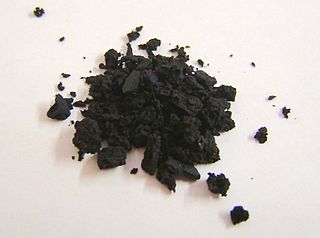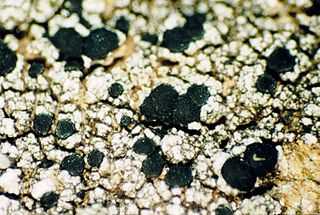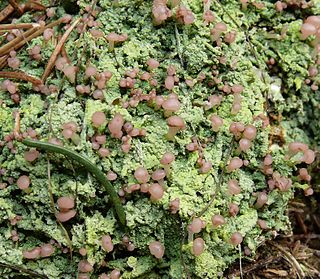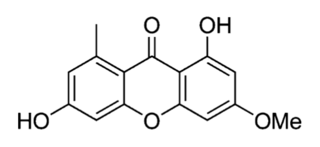
Litmus is a water-soluble mixture of different dyes extracted from lichens. It is often absorbed onto filter paper to produce one of the oldest forms of pH indicator, used to test materials for acidity. In an acidic medium, blue litmus paper turns red, while in a basic or alkaline medium, red litmus paper turns blue.

The Lecanoraceae are a family of lichenized fungi in the order Lecanorales. Species of this family have a widespread distribution.

The Baeomycetales are an order of mostly lichen-forming fungi in the subclass Ostropomycetidae, in the class Lecanoromycetes. It contains 8 families, 33 genera and about 170 species. As a result of molecular phylogenetics research published in the late 2010s, several orders were folded into the Baeomycetales, resulting in a substantial increase in the number of taxa.

Cetrelia is a genus of leafy lichens in the large family Parmeliaceae. They are commonly known as sea-storm lichens, alluding to the wavy appearance of their lobes. The name of the genus, circumscribed in 1968 by the husband and wife lichenologists William and Chicita Culberson, alludes to the former placement of these species in the genera Cetraria and Parmelia.
Lecanora xanthoplumosella is a species of crustose lichen in the family Lecanoraceae. Known from Australia, it was described as new to science in 2011.

Dibaeis baeomyces, commonly known as pink earth lichen, is a fruticose lichen belonging to the family Icmadophilaceae.
Buellia asterella, commonly referred to as the starry breck lichen, is a rare, black and white lichen in the family Caliciaceae. Once found all across the central European grasslands, it was described as new to science in 1974. Today, it is classified by the IUCN Red List as Critically Endangered and only found in select regions in Norway and Germany.

Schaereria is a genus of lichen-forming fungi. It is the sole genus in the family Schaereriaceae, which itself is the only family in the Schaereriales, an order in the subclass Ostropomycetidae of the class Lecanoromycetes.

Lichexanthone is an organic compound in the structural class of chemicals known as xanthones. Lichexanthone was first isolated and identified by Japanese chemists from a species of leafy lichen in the 1940s. The compound is known to occur in many lichens, and it is important in the taxonomy of species in several genera, such as Pertusaria and Pyxine. More than a dozen lichen species have a variation of the word lichexanthone incorporated as part of their binomial name. The presence of lichexanthone in lichens causes them to fluoresce a greenish-yellow colour under long-wavelength UV light; this feature is used to help identify some species. Lichexanthone is also found in several plants, and some species of fungi that do not form lichens.

Griseoxanthone C is an organic compound in the structural class of chemicals known as xanthones. Its chemical formula is 1,6-dihydroxy-3-methoxy-8-methylxanthen-9-one, and its molecular formula is C15H12O5. It is found in a plant and some fungi, including a lichen.

Sekikaic acid is an organic compound in the structural class of chemicals known as depsides. It is found in some lichens. First isolated from Ramalina sekika, it is a fairly common lichen product in the genera Ramalina and Cladonia. The species epithet of the powdery lichen Lepraria sekikaica refers to the presence of this substance—a rarity in genus Lepraria.

Siegfried Huneck was a German chemist and lichenologist. Much of his scientific career was hampered by the political situation in the former German Democratic Republic. He rejected pursuing a career in academia, and instead ended up working at the Leibniz Institute of Plant Biochemistry, a public research institute, from 1969 until his retirement in 1993. Despite his relative isolation and restricted freedoms in East Germany, Huneck had numerous professional contacts both in Germany and abroad, and was a highly published scholar. Many of his more than 400 scientific publications dealt with the chemistry of lichen products. He was awarded the Acharius Medal for lifetime achievements in lichenology in 1996.
Lecanora panticapaensis is a species of saxicolous (rock-dwelling), crustose lichen in the family Lecanoraceae. It occurs in a single locality in Dnipropetrovsk Oblast, Ukraine, where it grows on the vertical surfaces of black schist beside a river.

Solorinic acid is an anthraquinone pigment found in the leafy lichen Solorina crocea. It is responsible for the strong orange colour of the medulla and the underside of the thallus in that species. In its purified crystalline form, it exists as orange-red crystals with a melting point of 201 °C (394 °F).
Hannes Hertel is a German botanist and taxonomist and was Director of the State Herbarium in Munich, Germany 1992 - 2004. His specialist areas are the fungi and lichens.
Christian Leuckert was a lichen taxonomist who applied the diversity of secondary metabolites within lichens as useful taxonomic criteria. He was Director of the Institute of Plant Systematics and Plant Geography at the Free University of Berlin from the 1970s until 1995.
Lecanora compallens is a species of corticolous (bark-dwelling) crustose lichen in the family Lecanoraceae. Found in Asia and Europe, it was formally described as a new species in 1999 by lichenologists Kok van Herk and André Aptroot. The type specimen was collected by the first author from Drouwenerveen (Drenthe), where it was found growing on the bark of Quercus robur. The species epithet compallens is derived from the Latin com and (ex)pallens, alluding to the typical occurrence of the morphologically similar Lecanora expallens at the same location.
Microcrystallization is a method for identifying lichen metabolites that was predominantly used before the advent of more advanced techniques such as thin-layer chromatography and high-performance liquid chromatography. Developed primarily by Yasuhiko Asahina, this approach relies on the formation of distinctive crystals from lichen extracts. Although now superseded by modern analytical methods, microcrystallization still holds importance for compound purification and analysis using X-ray crystallography.

Verseghya thysanophora, commonly known as the mapledust lichen, is a species of mostly corticolous (bark-dwelling), leprose lichen in the family Pertusariaceae. This common species is widely distributed in the Northern Hemisphere. The thallus of the lichen is a thin patchy layer of granular soredia, pale green to yellowish green in colour. The main characteristics of the lichen include the presence of lichen products known as thysanophora unknowns, and the conspicuous white, fibrous prothallus that encircles the thallus.











